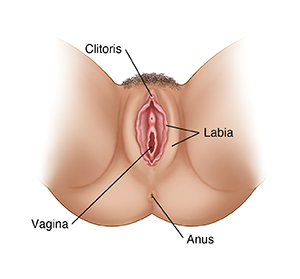Understanding Vulvar Biopsy
A vulvar biopsy is a test used to check for vulvar cancer or another skin disease affecting the vulva. The vulva is the outer part of a woman’s genitals. It includes the inner and outer lips (labia) of the vagina, the clitoris, the opening of the vagina and its glands, and the skin between the vagina and the anus.
During a biopsy, small tissue samples are taken from changed (abnormal) areas. The tissue is then sent to a lab and tested for cancer or other types of skin disease.

How to say it
VUHL-vuhr BY-op-see
Why a vulvar biopsy is done
A vulvar biopsy may be done if you have signs and symptoms such as:
-
Areas of skin on your vulva that are white or that turn white after a diluted vinegar-like solution is put on them
-
Patches of skin that are red, pink, gray, brown, black, or bumpy
-
A sore that doesn’t heal
- Thicker skin or a lump or growth on the vulva
-
Genital warts that don’t go away
-
Itching, pain, or burning
-
Bleeding or discharge that isn't related to a normal period
How a vulvar biopsy is done
A biopsy is a quick procedure. It’s often done in a healthcare provider’s office. You may be told to take over-the-counter pain medicine before the biopsy. This can help lessen pain after the biopsy.
This is what a biopsy may be like:
- The healthcare provider may use a tool called a colposcope to do the biopsy. This scope has magnifying lenses that let the provider clearly see even small changed areas of skin. The scope stays outside your body. It doesn’t touch you.
- The skin in the area is cleaned with special swabs. Medicine may be put on the skin to numb it. Then a small needle is used to inject medicine into the area to help prevent pain during the biopsy.
-
When the area is numb, the provider will remove a tiny piece (sample) of the changed skin. This is done with a small sharp tool. This is called a punch biopsy. Sometimes an incisional biopsy is done. This is when a thin slice of the skin is removed with a sharp blade (scalpel). In some cases, the entire patch of changed skin is removed. This is called an excisional biopsy. A clotting material may be put on the biopsy site to stop any bleeding. Your healthcare provider will tell you which kind of biopsy you will have.
-
If the provider takes a larger piece of skin, the area will then be closed with stitches (sutures).
-
You'll be told how to care for the area to help it heal after the biopsy.
The tissue removed during the biopsy is then checked under the microscope and tested by a healthcare provider called a pathologist. This provider looks for precancer or cancer cells in the biopsy sample. Tests can also show the presence of some other skin diseases. Ask your healthcare team how soon you'll get the results of your biopsy. Your healthcare provider will tell you if you need any follow-up tests.
Risks of a vulvar biopsy
-
Pain
-
Infection
-
Bleeding
-
Blood blister (hematoma)
-
Bruising
-
Loss of skin color (hypopigmentation) or increased skin color (hyperpigmentation) in the biopsy area
-
Scarring
Know what to expect after the biopsy. Ask what type of pain medicine you can use and how to care for the biopsy area. Also ask your healthcare provider what signs to watch for and when to call. Know how to get help after office hours and on weekends and holidays.